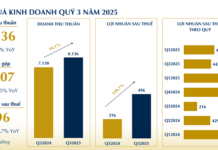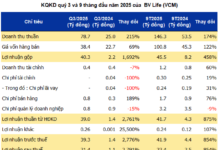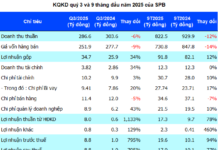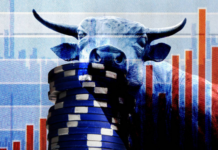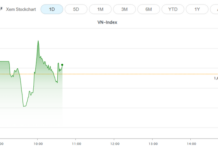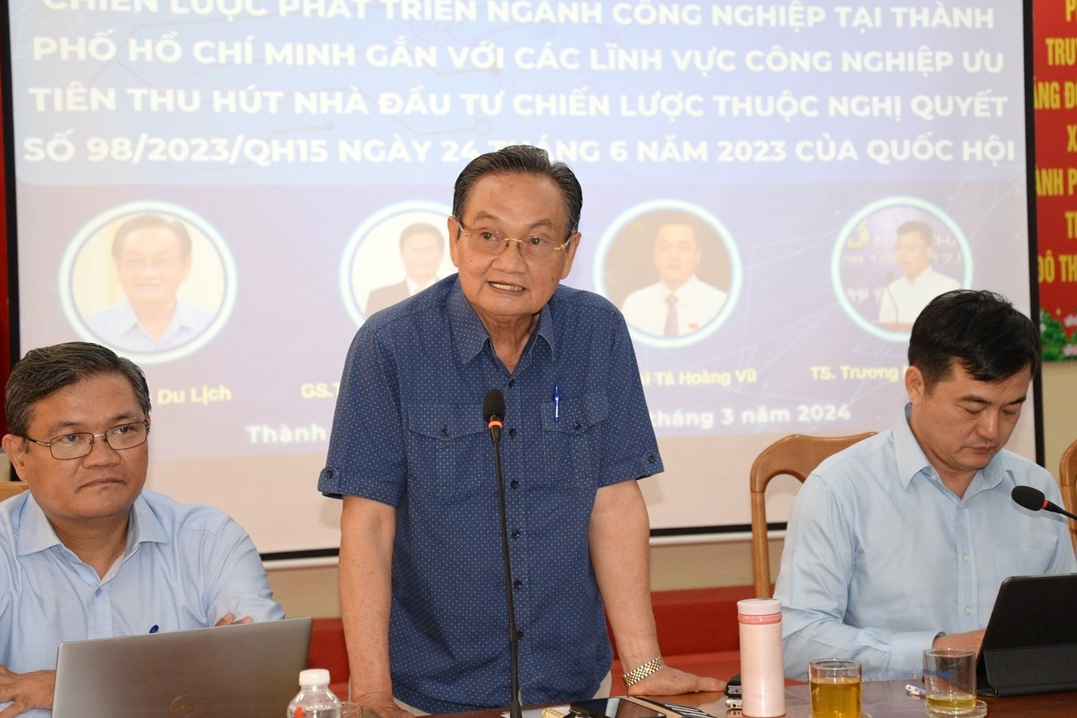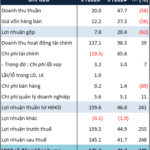On the morning of March 12, the Ho Chi Minh City Development Research Institute organized a strategic scientific conference on the development of industries connected with priority industries attracting strategic investors according to Resolution 98.
At the conference, Dr. Tran Du Lich said that the city’s policy was to shift the economic structure from labor-intensive and land-intensive industries to technology-intensive and capital-intensive industries from 2006-2010. However, the process has been slow due to various reasons.
In particular, for Ho Chi Minh City, urban development land is more attractive than industrial development. Therefore, the city’s industrial land is expensive, and only industries with high capital intensity can afford it, otherwise, it is difficult to compete in terms of land prices.

Dr. Tran Du Lich speaking at the conference. Photo: Ho Van |
In addition, Ho Chi Minh City has many industrial sectors, but it has not yet established leading pioneers in these industries. It has not formed any development focal points to lead the way. These weaknesses need to be overcome in the industrial development strategy.
According to Tran Viet Ha, Deputy Director of the Management Board of Export Processing Zones and Industrial Parks of Ho Chi Minh City (HEPZA), initially, the industries attracted were those that could take advantage of the city’s and Vietnam’s strengths, such as textiles, leather, mechanics, and plastics. But currently, the trend is to focus on high-tech industries, especially semiconductor chips…
However, when looking back and comparing with the surrounding localities, the city’s industrial attraction has weak points.
First of all, the city is the first unit in the whole country to take the lead in developing industrial zones. The first companies that were attracted have now become obsolete and are no longer suitable for the city’s priority industries.
Cheap labor and abundant resources are no longer competitive advantages. Many surrounding areas have become urbanized, and industrial zones are squeezed in the middle of residential areas. Therefore, how to transform towards high-tech industries is an inevitable requirement in the current context. “To attract high-tech industries, the city is currently facing a shortage of land,” according to Mr. Ha.
Mr. Pham Van Viet, Vice Chairman of the High-Quality Vietnam Garment Enterprises Association, believes that a multi-functional fashion center should be established, including human resource training, fashion design, technology application research, and fashion events organization. This is a long-term national strategic project that requires an area of up to 100 hectares.
“Recently, we have searched in all districts and districts, but still unable to find suitable land according to the plan. According to research, perhaps Can Gio District is suitable because it does not affect the environment,” Mr. Viet said.
Protecting businesses and production
According to Assoc. Prof. Dr. Nguyen Anh Thi, Head of the Management Board of the High-Tech Park, for Ho Chi Minh City, industrial development should be knowledge-intensive, not just capital-intensive. Industrial development must be based on strong foundations such as labor, science and technology, and innovation. The priority sector should focus on biotechnology, semiconductors…
 Dr. Nguyen Anh Thi raises issues at the workshop. |
According to Dr. Thi, in the global value chain of design – production – packaging, Vietnam has only been able to handle the design and packaging stages, not production.
Also according to Dr. Thi, land cannot be a competitive advantage, it should be knowledge-intensive. Human resources are the most important resource and the strength of Ho Chi Minh City, and the important resource of overseas Vietnamese cannot be overlooked.
According to Ms. Vu Kim Hanh, Chairman of the High-Quality Vietnamese Enterprise Association, we discussed the development strategy of the industrial sector, but in the short term, we need to protect businesses and production from the trend of foreign companies acquiring Vietnamese companies.
According to Ms. Hanh, currently, the situation of buying and selling companies is quite hot. “We are quite concerned about the acquisition of Vietnamese companies. We have quietly collected data and discovered some very illogical things,” Hanh said.
According to her, there are countries that come and buy Vietnamese companies like they buy vegetables. Especially since 2018, Thai companies have frequently acquired Vietnamese companies.
After a successful acquisition, they have ways to introduce foreign goods, label them as Vietnamese, and sell them in the market.
According to Ms. Hanh, this is also a way to eliminate the Vietnamese industry. This is a cause for concern when looking at the production perspective.
“For example, they import Chinese goods to test on the market, and then see which ones sell well, are suitable for consumer taste, and then start producing those items… This is very difficult to detect,” Hanh raised concerns.
To fight against this situation, according to Ms. Hanh, some countries have laws to make them transparent and protect their industries. For example, Japan stipulates that by 2025, any country that sells goods online to Japan must declare and have an official branch in Japan to be responsible for consumers and pay full taxes, avoiding goods flooding through the border, causing damage to domestic producers. Even Singapore has a law that domestic companies have to apply for government permission if they sell more than 5% of shares.
“The fact that they have laws shows that they have a real concern to protect their industries,” Hanh affirmed.
Ho Van













